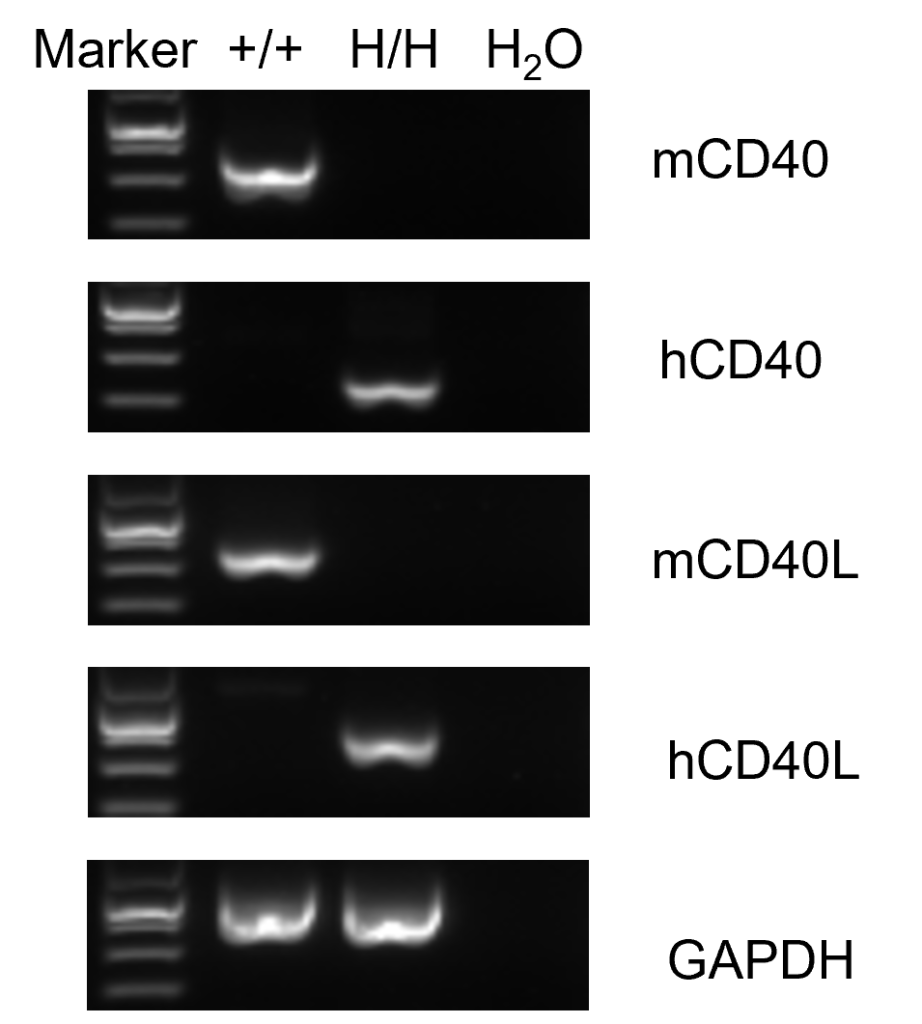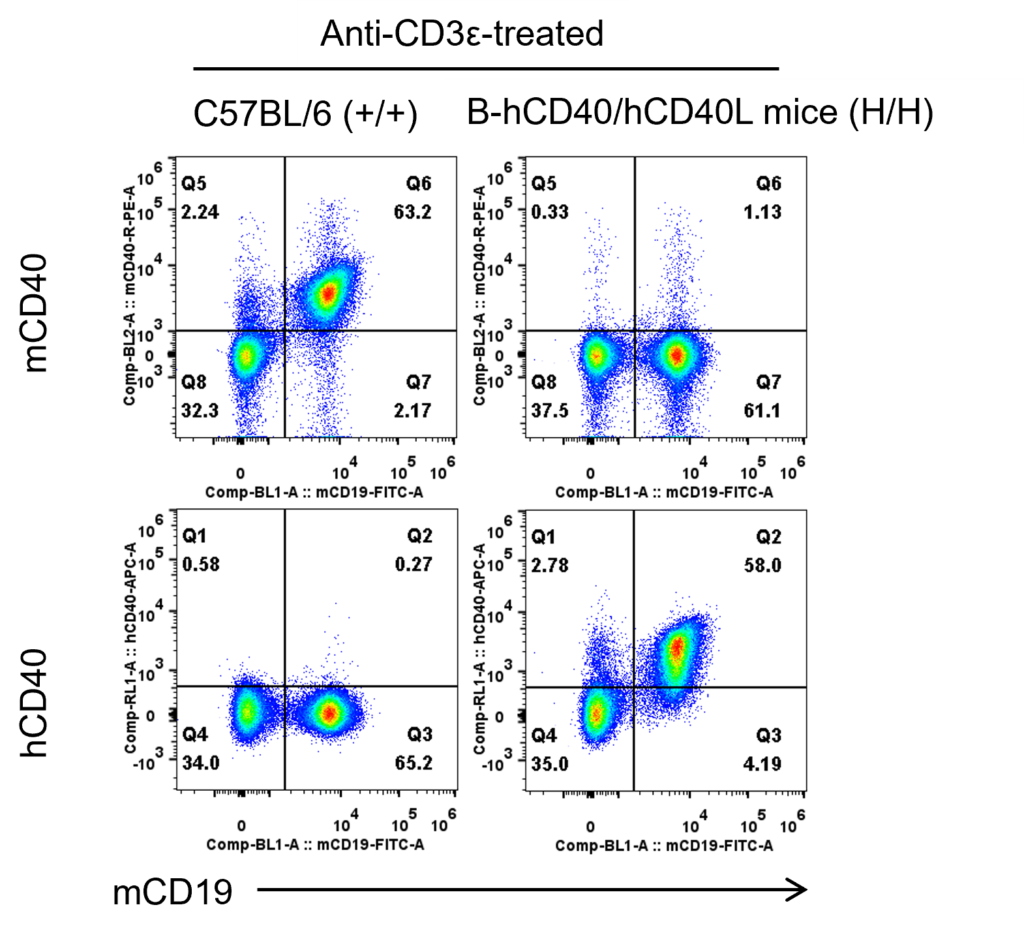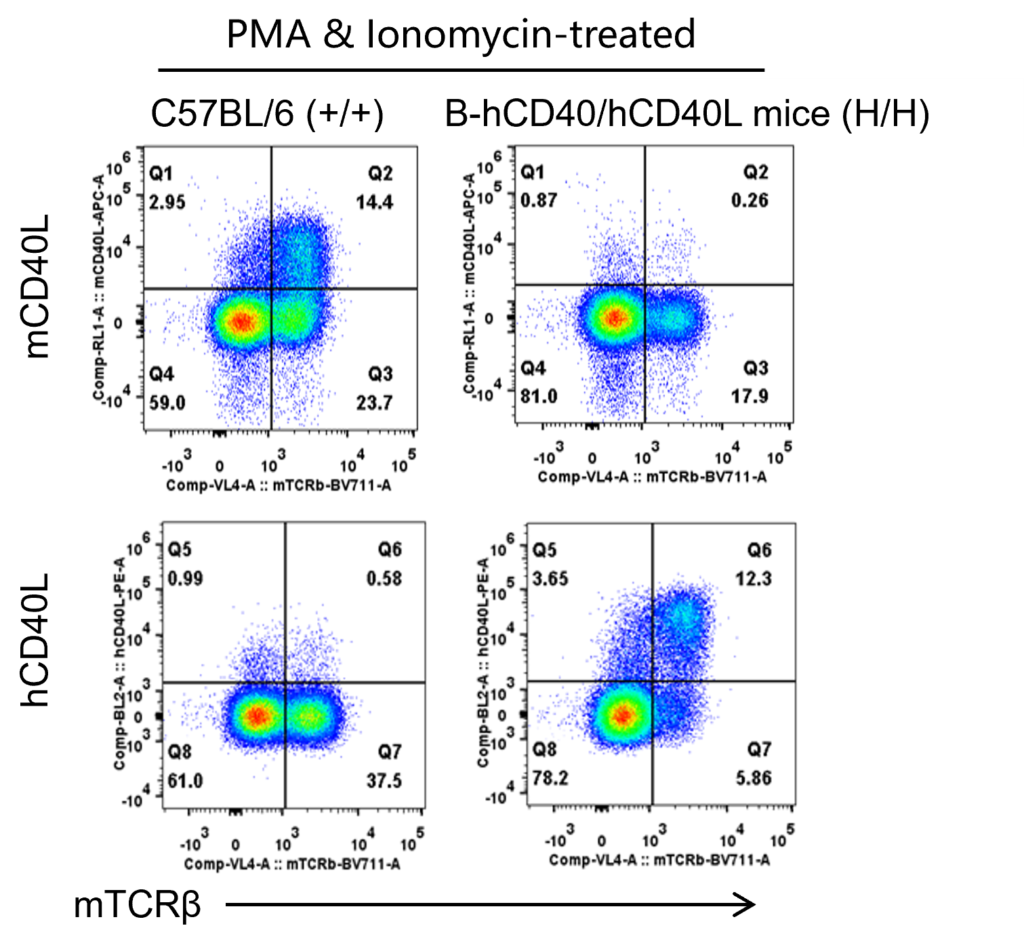Basic Information
-
Gene Targeting Strategy

-
Gene targeting strategy for B-hCD40/hCD40L mice. The exon 2-7 of mouse Cd40 gene that encodes the extracellular region coding sequences were replaced by human CD40 exons 2-7 in B-hCD40/hCD40L mice. The exons 2-5 of mouse Cd40l gene that encode the extracellular region coding sequences were replaced by human CD40L exons 2-5 in B-hCD40/hCD40L mice.
-
mRNA Expression Analysis

-

Strain specific analysis of CD40/CD40L gene expression in wild-type C57BL/6 mice and B-hCD40/CD40L mice by RT-PCR. Mouse CD40/CD40L mRNA was detectable in splenocytes of wild-type C57BL/6 mice (+/+). Human CD40/CD40L mRNA was detectable only in homozygous B-hCD40/CD40L (H/H), but not in wild-type mice.
-
Protein Expression Analysis

-

Strain specific CD40 expression analysis in homozygous B-hCD40/hCD40L mice by flow cytometry. Splenocytes were collected from wild-type C57BL/6 mice (+/+) and homozygous B-hCD40/hCD40L mice (H/H) stimulated with anti-CD3ε in vivo (7.5 μg/mice, stimulation for 24 hours, i.p.), and analyzed by flow cytometry with species-specific anti-CD40 antibody. Mouse CD40 was detectable in wild-type mice. Human CD40 was exclusively detectable in homozygous B-hCD40/hCD40L but not in wild-type mice.

Strain specific CD40L expression analysis in homozygous B-hCD40/hCD40L mice by flow cytometry. Thymocytes were collected from wild-type C57BL/6 mice (+/+) and homozygous B-hCD40/hCD40L mice (H/H) and stimulated with PMA & Ionomycin, then analyzed by flow cytometry with species-specific anti-CD40L antibody. Mouse CD40L was detectable in wild-type mice. Human CD40L was exclusively detectable in homozygous B-hCD40/hCD40L but not in wild-type mice.
-
In Vivo Efficacy of Anti-CD40 and Anti-CD40L Antibodies

-


B-hCD40/hCD40L mice was used to establish The T-Dependent Antibody Response assay (TDAR assay) and evaluate the efficacy of anti-CD40 and anti-CD40L antibody. B-hCD40/hCD40L mice (n=5) were intraperitoneally immunized with 100 μg KLH on Day 1 and treated with anti-CD40L (provided by the client) or bleselumab (anti-CD40) (in house). Blood was collected on Day 7 and Day 14 and analyzed by ELISA with KLH specific IgG antibody and KLH specific IgM antibody. (A) Body weight of B-hCD40/CD40L mice increased steadily; (B, C) Concentration of mouse KLH specific IgG and IgM were significantly increased after immunization. But the concentration of KLH specific IgG and IgM in the groups treated with anti-CD40L antibody or bleselumab were significantly decreased when compared to that in the control group, demonstrating that the B-hCD40/hCD40L mice provide a powerful preclinical model for in vivo evaluation of anti-CD40 and anti-CD40L antibodies.
-
Summary

-
mRNA expression analysis:
Mouse Cd40 and Cd40l mRNA was detectable in spleen of wild-type mice (+/+). Human CD40 and CD40L mRNA was detectable in spleen of B-hCD40/hCD40L mice (H/H) but not in wild-type mice.
Protein expression analysis:
Human CD40 was exclusively detectable in splenocytes of homozygous B-hCD40/hCD40L but not in wild-type mice.
Human CD40L was exclusively detectable in thymocytes of homozygous B-hCD40/hCD40L but not in wild-type mice.
In vivo efficacy
The B-hCD40/CD40L mice can be used to evaluate the efficacy of anti-CD40 and anti-CD40L antibodies.


